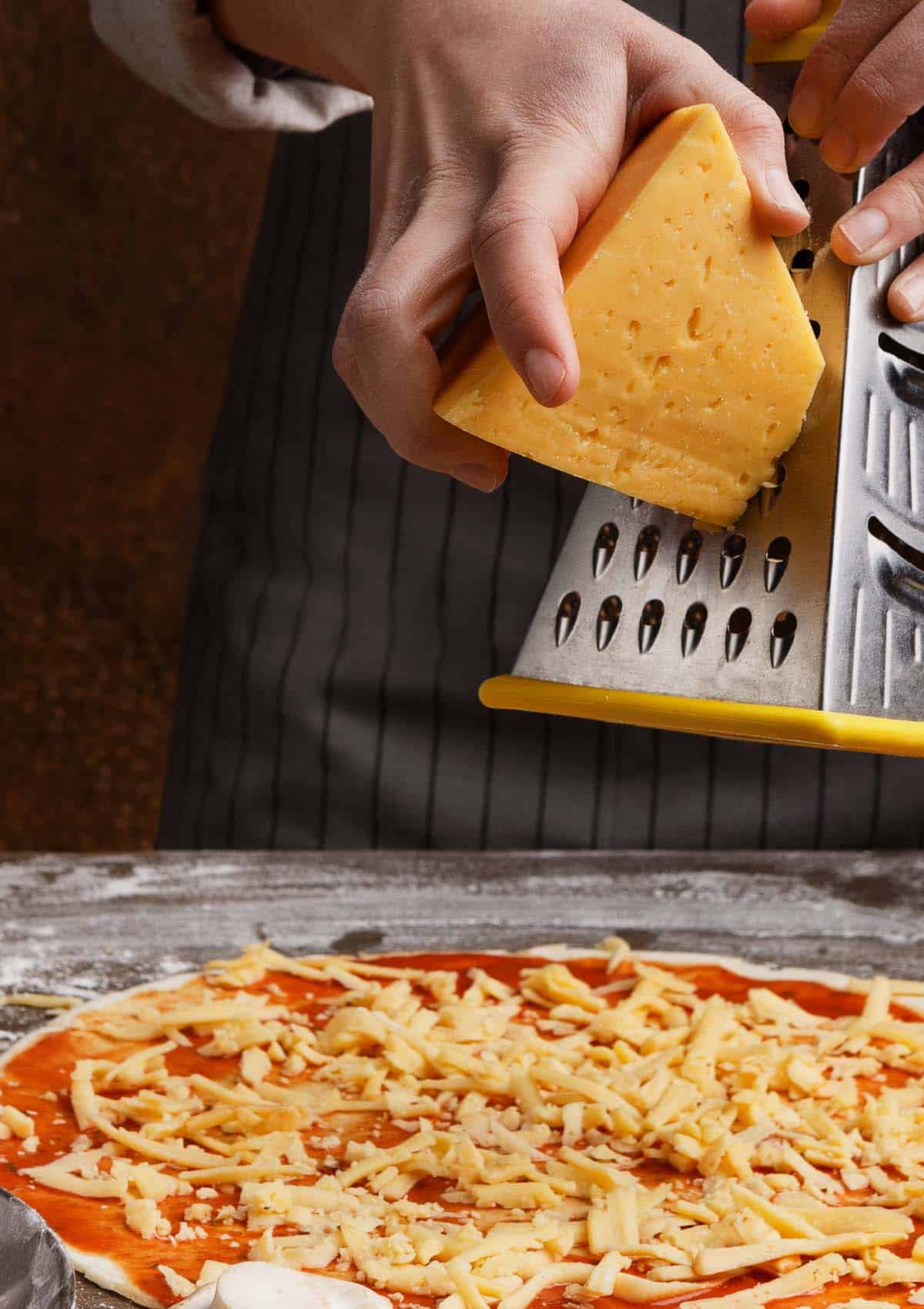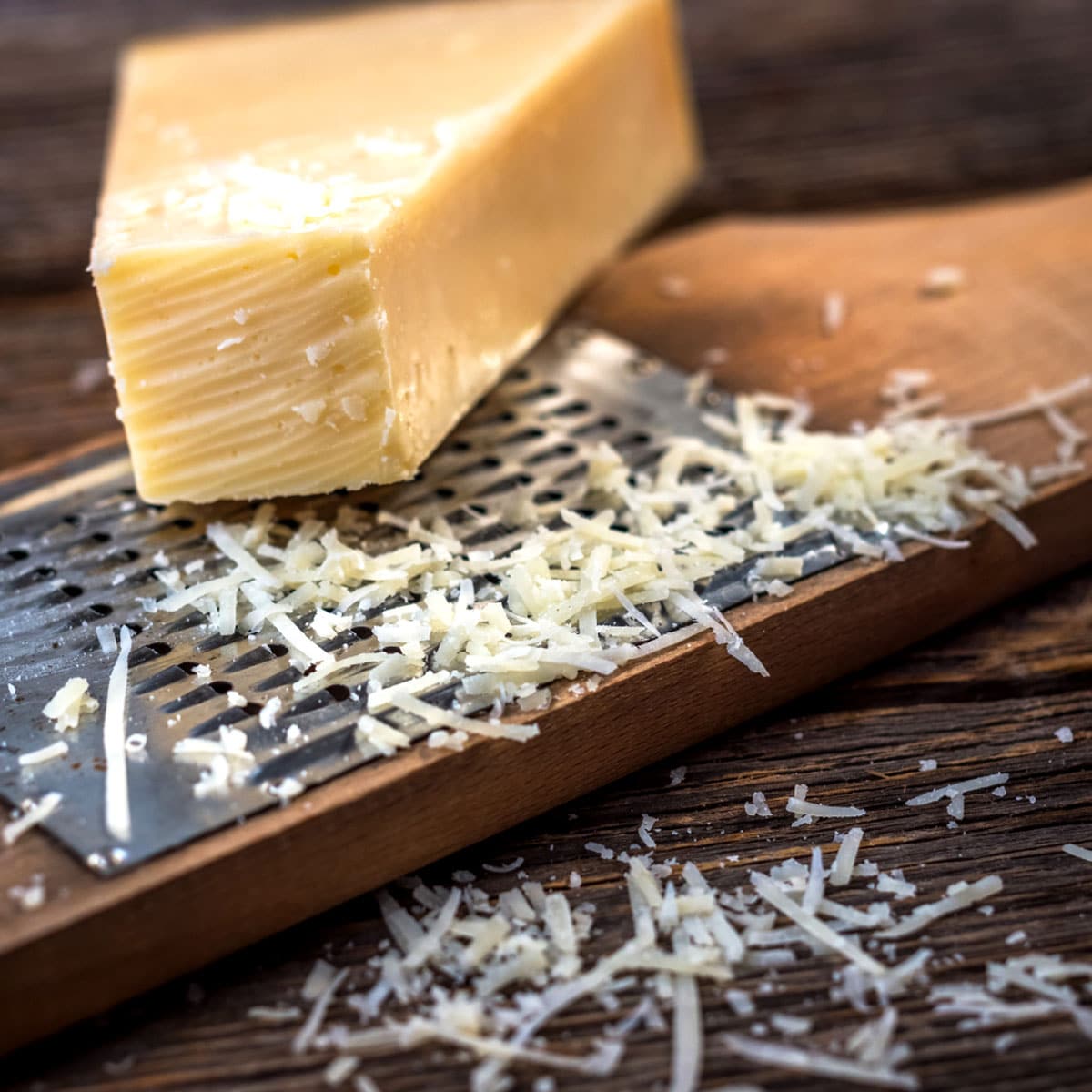Have you ever opened a bag of shredded cheese only to find that it has clumped together into one solid mass? It can be frustrating to separate the cheese, making it difficult to measure the right amount for your recipe. Luckily, you can use a few easy tricks to prevent shredded cheese from clumping together.
Jump to:
Factors that contribute to the clumping of shredded cheese?
Shredded cheese is prone to clumping because it is made up of tiny, thin strands of cheese that can easily stick together. This is especially true for cheeses high in moisture content, such as mozzarella.
Several factors can contribute to the clumping of shredded cheese. These include:
- Moisture content: If the cheese is too moist, it can clump together when it is shredded. This is because the moisture in the cheese will cause the shreds to stick together.
- Type of cheese: Some cheese is more prone to clumping than others. For example, soft and crumbly cheeses like feta or blue cheese are more likely to clump than hard and dry cheeses like cheddar or Parmesan.
- Storage conditions: If the cheese is stored in a humid environment, it can become moist and clump together.
- Shredding method: How the cheese is shredded can also contribute to clumping. Shredding cheese too finely or with too much force can cause the shreds to stick together.
- Age of the cheese: Older cheese tends to be drier and less prone to clumping than fresh cheese.

Read:
Why does shredded cheese clump together?
It's a common problem when you take out the cheese from the fridge, which has simple answers.
1 The pliability of cheese shreds:
Cheese shreds are not rigid, like wood; they are pliable and flexible. As a result, if you pile them, they will gradually bend and deform due to their own weight.
2 The fusing and clumping of cheese shreds
When cheese is removed from the refrigerator, the buttery oils within it become slightly softer, similar to how butter melts. This allows the cheese shreds to fuse to some extent. When you put the cheese back in the refrigerator, the buttery oils solidify, causing the cheese shreds to adhere closely to each other. The result is a clump of cold, hard cheese.
3 The role of moisture in clumping cheese shreds
Shredded cheese clumps together because of its high moisture content – when exposed to air, the surface of the cheese starts to dry out and form a kind of shell that helps hold the pieces together.
4 Surface area and humidity
Shredding the cheese creates more surface area for the casein to adhere to, which can also contribute to clumping. The humidity in the air can also affect the cheese's tendency to clump, as high humidity can cause the cheese to become more moist and sticky, leading to clumping.
How to prevent shredded cheese from sticking together
There are a few simple steps you can take to keep shredded cheese from clumping together:
1 Store shredded cheese properly:
I recently discovered a simple trick to store shredded cheese without clumping together in the refrigerator or freezer. You only need 1 - 2 tablespoons of cornstarch and a zip bag. Put the cheese in the bag, add the cornstarch, and shake vigorously until evenly distributed throughout the cheese. It's incredible how one simple ingredient can make such a difference!
This is the same trick pre-shredded cheese bags in the supermarket use, but instead of using cellulose as their anti-clumping agent, you're using cornstarch. I love this little trick because it helps keep my shredded cheese fresher for longer!
Update: I've tried this with Parmesan, too, and it works a treat. It's great for keeping the cheese from clumping together, so you don't have to spend time breaking it up before using it. Give it a go - you won't regret it! 🙂
2 Keep cheese from drying out with proper airflow management:
One way to keep shredded cheese from drying out is to manage the airflow around the cheese. Proper airflow can help to prevent the cheese from becoming hard and clumpy. Here are a few tips to help manage the airflow around your shredded cheese:
- Store shredded cheese in an airtight container or bag: This will prevent moisture from coming into contact with the cheese and causing it to clump.
- Skip the plastic wrap and use parchment paper. Wrap shredded cheese in parchment or wax paper before storing it to create an extra barrier against moisture
- Put a slice of bread: Place a small piece of bread in the container with the shredded cheese to absorb excess moisture.
- Keep the fridge at a consistent, cool temperature to prevent moisture from accumulating. Use the crisper drawer to store the shredded cheese.
- Avoid damp hands when handling shredded cheese: Moisture from your hands can transfer to the cheese and cause it to clump.
- Consider using a humidity-controlled storage container: The containers maintain low humidity and help prevent shredded cheese from clumping due to moisture.
- Freeze shredded cheese: If you have a large amount of it that you won't be able to use within a few weeks, you can freeze it for longer storage. You can freeze shredded cheese in an airtight container for up to 3 months. This will help to prevent moisture from coming into contact with the cheese and causing it to clump.
- Use cheese within a reasonable timeframe: To prevent the cheese from drying out, it's essential to use it within a reasonable timeframe. Follow the expiration date on the package, or use your best judgment to determine how long the cheese will last.
Read:
3 Prevent clumping with coarsely shredded cheese:
Use a coarse shredder if you use a block of cheese and shred it yourself. Coarsely shredded cheese is less likely to clump together than finely shredded cheese. There are a few reasons for this:
- Surface area: Coarsely shredded cheese has larger pieces with a larger surface area. This allows the cheese to melt more evenly and prevents clumps from forming. On the other hand, finely shredded cheese has smaller pieces with a smaller surface area, making it more prone to clumping.
- Moisture content: Coarsely shredded cheese tends to have a lower moisture content than finely shredded cheese, as the larger pieces can retain moisture better. This means that humidity makes coarsely shredded cheese less prone to clumping.
- Cellulose content: As mentioned earlier, cellulose is a plant-based ingredient often added to shredded cheese to prevent it from clumping. Coarsely shredded cheese may contain less cellulose than finely shredded cheese, as the larger pieces do not require as much cellulose to prevent them from sticking together. This means that coarsely shredded cheese is less prone to clumping due to cellulose.
4 Revive clumped cheese with simple break-up techniques:
If you use a bag of shredded cheese that has already clumped together, try breaking it up with a fork or your fingers. You can also use a sharp knife to chop the clumps into smaller pieces.
5 Prevent clumps with cornstarch or flour:
One of the easiest methods is to give the cheese a quick toss in cornstarch before adding it to whatever dish you're making – this helps keep moisture away from the exterior, preventing case hardening and clumping.
How to do it:
- To use this method, mix a small amount of cornstarch or flour (about 1 tablespoon per cup of shredded cheese) into the cheese before storing it or using it in a recipe.
- You can also sprinkle a small amount of cornstarch or flour over the cheese when ready to use it.
6 Choose the right cheese:
The type of cheese used can affect the tendency for shredded cheese to clump. Harder, aged cheeses such as Parmesan and cheddar tend to shred more finely and are less prone to clumping.

7 Buy low-moisture pre-shredded cheese:
You could also look for pre-shredded cheese labeled "low moisture" on the packaging, indicating that it has been treated with an anti-clumping agent before being sold.
8 Grate your own cheese:
Lastly, you can always grate your own fresh cheese for dishes requiring extra finesse!
Shelf life of cheese: Comparison table
The cheese's shelf life depends on the cheese type and moisture content. Soft cheeses generally have a shorter shelf life than hard cheeses. The following table shows the estimated fridge life of various popular kinds of cheese:
| Type of Cheese | Shelf Life (After Opening)(source) |
|---|---|
| Hard Cheese | 3-4 weeks |
| Soft Cheese | 1 week |
| Blue Cheese | 3-4 weeks |
| Feta Cheese | 7-10 days |
| Brie Cheese | 7 days |
| Cream Cheese | 1 month |
| Cottage Cheese | 7 days |
| Ricotta Cheese | 7 days |
| Shredded Cheese | 1 month |
How to Store Cheese: Tips and Tricks
In addition to preventing clumping, there are a few other things you can do to ensure that your cheese stays fresh and flavorful:
1 Wrap cheese properly:
To keep cheese fresh and prevent it from drying, it's essential to wrap it tightly in cheese paper, parchment, or wax paper. This will also help to prevent the cheese from picking up odors from other foods in the fridge.
Why not wrap cheese in plastic?
I've learned from experience why it's important not to wrap cheese in plastic. Wrapping cheese in plastic alone can lead to a few problems.
- The plastic wrap traps moisture, causing the cheese to spoil faster due to mold growth.
- Not only that, but it can also permeate the cheese with funky plastic flavors.
You're much better off wrapping your cheese in specialty cheese paper first. That's why parchment or waxed paper is the way to go if you don't have cheese paper handy. Wrapping your cheese first in this will create a barrier that lets air flow and keeps flavor intact.
Once wrapped in paper, double-wrap it loosely with aluminum foil, and you can then place the paper-wrapped cheese in a partially sealed plastic bag, storage container, or plastic wrap. This way, you get the best of both worlds – the cheese gets to breathe and is protected from drying out. So remember: never wrap cheese directly in plastic! It's just not worth it.
2 Store cheese in the right location:
Proper storage is crucial in keeping cheese fresh and flavorful. Storing cheese in the wrong location can cause it to dry out or pick up unwanted odors from other foods, which can ruin its taste and texture.
Where is the best place to store your cheese?
According to the experts at Real Simple, the crisper drawer is the best spot. It will provide the most consistent temperature and humidity to keep your cheese in the best condition. If you're a real cheese lover, it might be worth dedicating an entire drawer of your fridge to storing all the delicious varieties!
One crucial factor to consider when storing cheese is its moisture content.
- Harder, aged cheeses such as cheddar and Parmesan have a lower moisture content and can be stored in the fridge or on the counter.
- Softer cheeses such as Brie and feta have a higher moisture content and should be stored in the fridge to prevent spoiling or drying out.
Another factor to consider is the presence of mold.
Some cheeses, like blue cheese and Brie, are meant to be aged with mold to develop their flavor. However, if these cheeses are not stored properly, the mold can grow out of control and spoil the cheese. Keeping cheese in an airtight container or wrapping it tightly in parchment or wax paper can help to prevent mold from growing.
3 Freeze the cheese:
If you have leftover cheese that you won't be able to use within a week or two, you can freeze it for longer storage. You can grate or shave hard cheeses like Parmesan and cheddar and store them in the freezer for up to 3 months. You can keep soft cheeses such as goat cheese and camembert for up to 3 months, but they may have a different texture when thawed. <source>
It's easy to store shredded cheese without having to thaw it first.
- Add some cornstarch, shake the cheese in a bag or container, and spread it in a single layer on a sheet pan.
- Put the pan in the freezer for about an hour until the cheese is frozen.
- Once that's done, you can transfer it to a zippered storage bag and store it in your freezer until you're ready to use it.
For convenience, you can portion the cheese into smaller bags with the quarter, half, or cup increments to have the right amount of shredded cheese for your recipe. Place those bags into a larger bag and store them in your freezer.
Note:
This advice is intended for cheddar and Monterey jack-style cheeses commonly found in supermarkets. However, you may want to reconsider when dealing with more expensive $15/ lb specialty cheeses since they may not preserve their quality when frozen for an extended period.
Factors to consider when choosing cheese for shredding.
The best cheese for shredding depends on your preferences and the specific dish you are making. Experiment with different cheeses to find the one that works best for you.
Here are a few factors to consider:
1 Moisture content:
Cheeses with a lower moisture content tend to shred more efficiently and produce finer, more evenly sized shreds. Harder, aged cheeses such as cheddar, Parmesan, and swiss tend to have lower moisture content and are suitable for shredding.
2 Flavor:
Consider the taste of the cheese and how it will complement the dish you are making. Some strong-flavored cheeses, such as blue cheese or gorgonzola, can be overwhelming when used in large quantities.
3 Melting properties:
Some cheeses melt more smoothly and evenly than others. Fat-rich cheeses, such as mozzarella and gouda, melt well and are ideal for dishes that involve melting cheese, like pizza or grilled cheese sandwiches.
4 Texture:
The texture of the cheese can also be a factor in its suitability for shredding. Some cheeses, such as feta and goat cheese, are crumbly and may not shred as well as firmer cheeses.
Read:
Best cheeses for shredding:
Many types of cheese are suitable for shredding, and the best choice will depend on the intended use of the cheese and personal preferences.
Here are a few types of cheese that are particularly good for shredding:
- Cheddar: Cheddar is a hard, sharp cheese with a moderate to high-fat content. It has a strong, distinctive flavor and a firm, smooth texture. Cheddar shreds well and produces evenly sized shreds. It is a good choice for various dishes, including pizza, tacos, and casseroles.
- Parmesan: Parmesan is a hard, aged cheese with a sharp, nutty flavor. It has a low moisture content and a crumbly texture. Parmesan shreds well and produces fine, evenly-sized shreds. It is a good choice for dishes where you want a strong, distinctive flavor, such as Caesar salad or spaghetti carbonara.
- Swiss: Swiss is a hard, pale yellow cheese with a mild, nutty flavor. It has a low moisture content and a smooth, creamy texture. Swiss shreds well and produces evenly sized-shreds. It is a good choice for dishes with a mild, creamy flavor, such as quiches or sandwiches.
- Mozzarella: Mozzarella is a soft, white cheese with a mild, creamy flavor. It has a high moisture content and a smooth, elastic texture. Mozzarella shreds well and produces evenly sized shreds. It is a good choice for dishes with a mild, creamy flavor and good melting properties, such as pizza or lasagna.
- Gouda: Gouda is a semi-hard cheese with a mild, buttery flavor. It has a moderate fat content and a smooth, creamy texture. Gouda shreds well and produces evenly-sized shreds. It is a good choice for dishes with a mild, creamy flavor and good melting properties, such as grilled cheese sandwiches or quesadillas.
- Colby: Colby is a semi-hard cheese with a mild, buttery flavor. It has a moderate moisture content and a smooth, creamy texture. Colby shreds well and produces evenly-sized shreds. It is a good choice for dishes with a mild, creamy flavor, such as grilled cheese sandwiches or quesadillas.
- Monterey Jack: Monterey Jack is a semi-hard cheese with a mild, slightly tangy flavor. It has a moderate moisture content and a smooth, creamy texture. Monterey Jack shreds well and produces evenly-sized shreds. It is a good choice for dishes with a mild, creamy flavor and good melting properties, such as quesadillas or grilled cheese sandwiches.
- Asiago: Asiago is a hard cheese with a sharp, nutty flavor. It has a low moisture content and a crumbly texture. Asiago shreds well and produces evenly-sized shreds. It is a good choice for dishes with a strong, distinctive flavor, such as Caesar salad or pasta dishes.
- Provolone: Provolone is a semi-hard cheese with a mild, slightly tangy flavor. It has a moderate moisture content and a smooth, creamy texture. Provolone shreds well and produces evenly-sized shreds. It is a good choice for dishes with a mild, creamy flavor and good melting properties, such as sandwiches or pizzas.
How to Keep Shredded Cheese from Sticking Together
Pin RecipeIngredients:
- Shredded cheese
Instructions:
How to keep shredded cheese from sticking together
- Store shredded cheese properly:I recently discovered a simple trick to store shredded cheese without clumping together in the refrigerator or freezer. You only need 1 – 2 tablespoons of cornstarch and a zip bag. Put the cheese in the bag, add the cornstarch, and shake vigorously until evenly distributed throughout the cheese.
- Keep cheese from drying out with proper airflow management:Proper airflow can help to prevent the cheese from becoming hard and clumpy. Here are a few tips to help manage the airflow around your shredded cheese:#1. Store shredded cheese in an airtight container or bag: This will prevent moisture from coming into contact with the cheese and causing it to clump.#2. Skip the plastic wrap and use parchment paper. Wrap shredded cheese in parchment or wax paper before storing it to create an extra barrier against moisture.#3. Put a slice of bread: Place a small piece of bread in the container with the shredded cheese to absorb excess moisture.#4 Keep the fridge at a consistent, cool temperature to prevent moisture from accumulating. Use the crisper drawer to store the shredded cheese.#5. Avoid damp hands when handling shredded cheese: Moisture from your hands can transfer to the cheese and cause it to clump.#6. Consider using a humidity-controlled storage container: The containers maintain low humidity and help prevent shredded cheese from clumping due to moisture.#7. Freeze shredded cheese: If you have a large amount of it that you won’t be able to use within a few weeks, you can freeze it for longer storage. You can freeze shredded cheese in an airtight container for up to 3 months. This will help to prevent moisture from coming into contact with the cheese and causing it to clump.#8. Use cheese within a reasonable timeframe: To prevent the cheese from drying out, it’s essential to use it within a reasonable timeframe. Follow the expiration date on the package, or use your best judgment to determine how long the cheese will last.
- Prevent clumping with coarsely shredded cheese:Use a coarse shredder if you use a block of cheese and shred it yourself. Coarsely shredded cheese is less likely to clump together than finely shredded cheese.
- Revive clumped cheese with simple break-up techniques:If you use a bag of shredded cheese that has already clumped together, try breaking it up with a fork or your fingers. You can also use a sharp knife to chop the clumps into smaller pieces.
- Prevent clumps with cornstarch or flour:One of the easiest methods is to give the cheese a quick toss in cornstarch before adding it to whatever dish you’re making – this helps keep moisture away from the exterior, preventing case hardening and clumping.How to do it:#1. To use this method, mix a small amount of cornstarch or flour (about 1 tablespoon per cup of shredded cheese) into the cheese before storing it or using it in a recipe.#2. You can also sprinkle a small amount of cornstarch or flour over the cheese when ready to use it.
- Choose the right cheese:The type of cheese used can affect the tendency for shredded cheese to clump. Harder, aged cheeses such as Parmesan and cheddar tend to shred more finely and are less prone to clumping.
- Buy low-moisture pre-shredded cheese:You could also look for pre-shredded cheese labeled “low moisture” on the packaging, indicating that it has been treated with an anti-clumping agent before being sold.
- Grate your own cheese:Lastly, you can always grate your own fresh cheese for dishes requiring extra finesse!
Please note that all nutrition information are just estimates. Values will vary among brands, so we encourage you to calculate these on your own for most accurate results.





